Discover 11 hidden attractions, cool sights, and unusual things to do in Alnwick (United Kingdom). Don't miss out on these must-see attractions: Alnwick Castle, Warkworth Castle, and Dunstanburgh Castle. Also, be sure to include The Alnwick Garden in your itinerary.
Below, you can find the list of the most amazing places you should visit in Alnwick (England).
Table of Contents
Alnwick Castle

Medieval castle with state rooms. Alnwick Castle is a castle and country house in Alnwick in the English county of Northumberland. It is the seat of The 12th Duke of Northumberland, built following the Norman conquest and renovated and remodelled a number of times. It is a Grade I listed building and as of 2012 received over 800,000 visitors per year when combined with adjacent attraction The Alnwick Garden.[1]
Address: off Narrowgate, NE66 1NQ Alnwick
Warkworth Castle
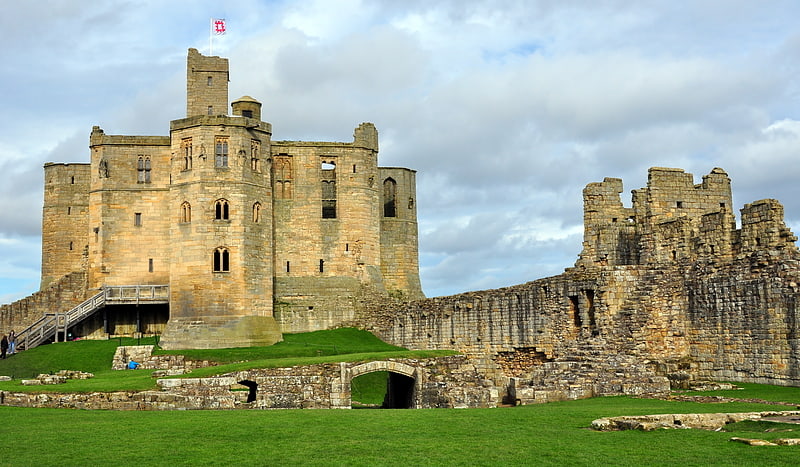
Ruined Medieval fortress. Warkworth Castle is a ruined medieval castle in Warkworth in the English county of Northumberland. The village and castle occupy a loop of the River Coquet, less than a mile from England's north-east coast. When the castle was founded is uncertain: traditionally its construction has been ascribed to Prince Henry of Scotland, Earl of Northumbria, in the mid-12th century, but it may have been built by King Henry II of England when he took control of England's northern counties. Warkworth Castle was first documented in a charter of 1157–1164 when Henry II granted it to Roger fitz Richard. The timber castle was considered "feeble", and was left undefended when the Scots invaded in 1173.
Roger's son Robert inherited and improved the castle. Robert was a favourite of King John, and hosted him at Warkworth Castle in 1213. The castle remained in the family line, with periods of guardianship when heirs were too young to control their estates. King Edward I stayed overnight in 1292 and John de Clavering, descendant of Roger fitz Richard, made the Crown his inheritor. With the outbreak of the Anglo-Scottish Wars, Edward II invested in castles including Warkworth where he funded the strengthening of the garrison in 1319. Twice in 1327 the Scots besieged the castle without success.
John de Clavering died in 1332 and his widow in 1345, at which point The 2nd Baron Percy of Alnwick took control of Warkworth Castle, having been promised Clavering's property by Edward III. Henry Percy, 1st Earl of Northumberland, added the imposing keep overlooking the village of Warkworth in the late 14th century. The fourth earl remodelled the buildings in the bailey and began the construction of a collegiate church within the castle, but work on the latter was abandoned after his death. Although The 10th Earl of Northumberland supported Parliament during the English Civil War, the castle was damaged during the conflict. The last Percy earl died in 1670. In the mid-18th century the castle found its way into the hands of Hugh Smithson, who married the indirect Percy heiress. He adopted the surname "Percy" and founded the dynasty of the Dukes of Northumberland, through whom possession of the castle descended.
In the late 19th century, the dukes refurbished Warkworth Castle and Anthony Salvin was commissioned to restore the keep. The 8th Duke of Northumberland gave custody of the castle to the Office of Works in 1922. Since 1984 English Heritage has cared for the site, which is a Grade I listed building and a Scheduled Ancient Monument.[2]
Address: Castle Terrace, NE65 0UJ Warkworth
Dunstanburgh Castle
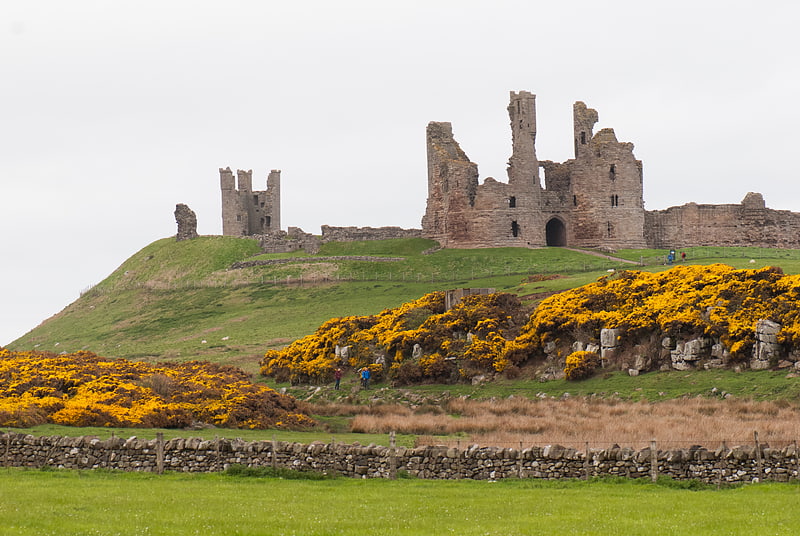
14th-century coastal castle ruins. Dunstanburgh Castle is a 14th-century fortification on the coast of Northumberland in northern England, between the villages of Craster and Embleton. The castle was built by Earl Thomas of Lancaster between 1313 and 1322, taking advantage of the site's natural defences and the existing earthworks of an Iron Age fort. Thomas was a leader of a baronial faction opposed to King Edward II, and probably intended Dunstanburgh to act as a secure refuge, should the political situation in southern England deteriorate. The castle also served as a statement of the earl's wealth and influence, and would have invited comparisons with the neighbouring royal castle of Bamburgh. Thomas probably only visited his new castle once, before being captured at the Battle of Boroughbridge as he attempted to flee royal forces for the safety of Dunstanburgh. Thomas was executed, and the castle became the property of the Crown before passing into the Duchy of Lancaster.
Dunstanburgh's defences were expanded in the 1380s by John of Gaunt, the Duke of Lancaster, in the light of the threat from Scotland and the peasant uprisings of 1381. The castle was maintained in the 15th century by the Crown, and formed a strategic northern stronghold in the region during the Wars of the Roses, changing hands between the rival Lancastrian and Yorkist factions several times. The fortress never recovered from the sieges of these campaigns, and by the 16th century the Warden of the Scottish Marches described it as having fallen into "wonderfull great decaye". As the Scottish border became more stable, the military utility of the castle steadily diminished, and King James I finally sold the property off into private ownership in 1604. The Grey family owned it for several centuries; increasingly ruinous, it became a popular subject for artists, including Thomas Girtin and J. M. W. Turner, and formed the basis for a poem by Matthew Lewis in 1808.
The castle's ownership changed during the 19th and 20th centuries; by the 1920s its owner Sir Arthur Sutherland could no longer afford to maintain Dunstanburgh, and he placed it into the guardianship of the state in 1930. When the Second World War broke out in 1939, measures were taken to defend the Northumberland coastline from a potential German invasion. The castle was used as an observation post and the site was refortified with trenches, barbed wire, pill boxes and a minefield. In the 21st century the castle is owned by the National Trust and run by English Heritage. The ruins are protected under UK law as a Grade I listed building, and are part of a Site of Special Scientific Interest, forming an important natural environment for birds and amphibians.
Dunstanburgh Castle was built in the centre of a designed medieval landscape, surrounded by three artificial lakes called meres covering a total of 4.25 hectares (10.5 acres). The curtain walls enclose 9.96 acres (4.03 ha), making it the largest castle in Northumberland. The most prominent part of the castle is the Great Gatehouse, a massive three-storey fortification, considered by historians Alastair Oswald and Jeremy Ashbee to be "one of the most imposing structures in any English castle". Multiple rectangular towers protect the walls, including the Lilburn Tower, which looks out towards Bamburgh Castle, and the Egyncleugh Tower, positioned above Queen Margaret's Cove. Three internal complexes of buildings, now ruined, supported the earl's household, the castle constable's household and the running of the surrounding estates. A harbour was built to the south-east of the castle, of which only a stone quay survives.[3]
Address: Dunstanburgh Road, NE66 3TT Craster
The Alnwick Garden
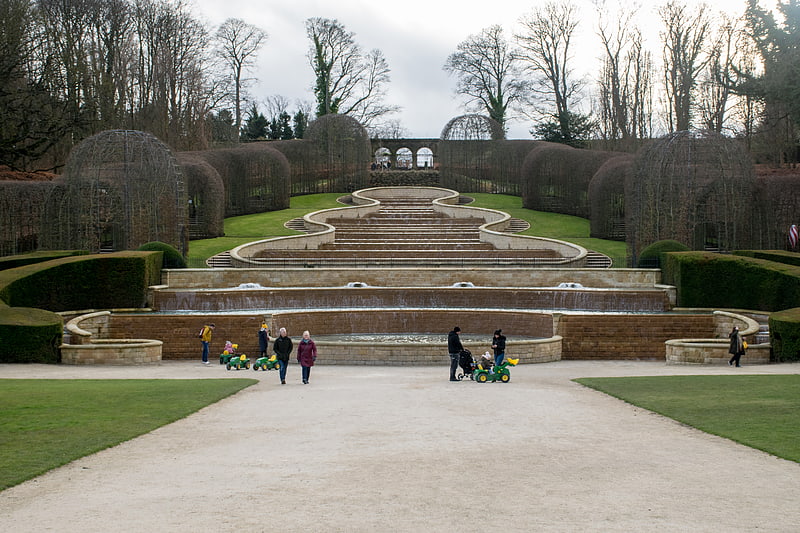
Garden in Alnwick, England. Alnwick Garden is a complex of formal gardens adjacent to Alnwick Castle in the town of Alnwick, Northumberland, England. The gardens have a long history under the dukes of Northumberland, but fell into disrepair until revived at the turn of the 21st century. The garden now features various themed plantings designed around a central water cascade. The revival of the gardens led to several public disputes between the Duchess of Northumberland and various garden experts concerning preservation and the use of public funds. The garden now belongs to a charitable trust, which is separate from Northumberland Estates, although the 12th Duke of Northumberland donated the 42-acre site and contributed £9 million towards redevelopment costs.[4]
Address: Denwick Ln, NE66 1YU Alnwick
Bailiffgate Museum
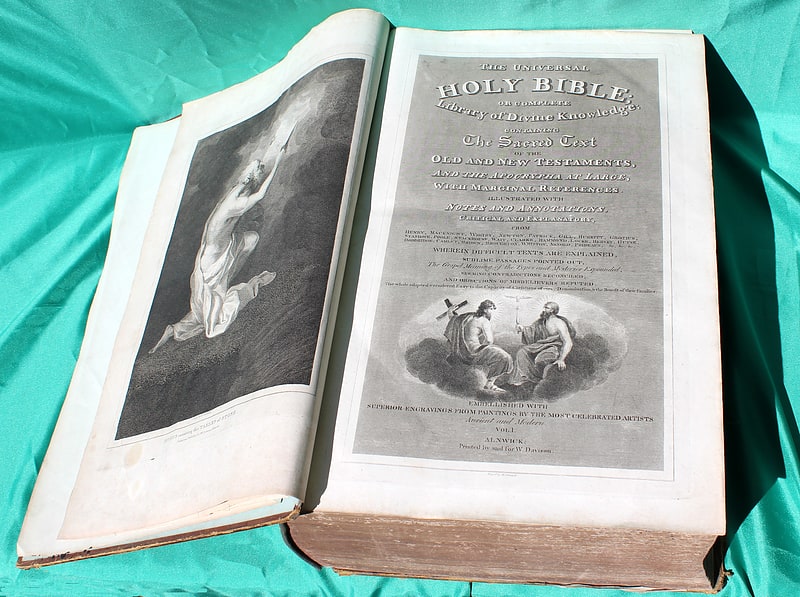
Museum in Alnwick, England. The Bailiffgate Museum is a small independent museum in Alnwick, Northumberland, England, dedicated to the history of Alnwick and North Northumberland. It is staffed by trustees and volunteers.[5]
Address: 14 Bailiffgate, NE66 1LX Alnwick
Chillingham Castle
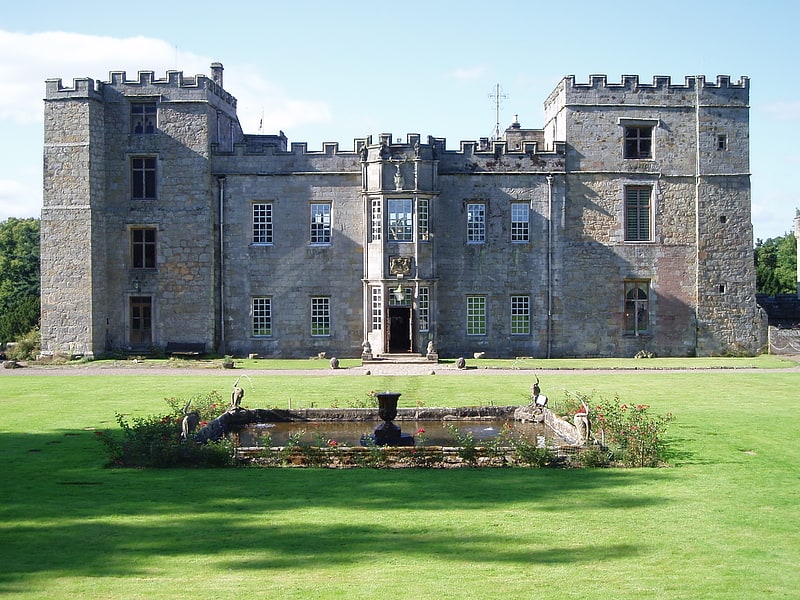
Medieval castle in Chillingham, England. Chillingham Castle is a medieval castle in the village of Chillingham in the northern part of Northumberland, England. It was the seat of the Grey and Bennett families from the 15th century until the 1980s, when it became the home of Sir Edward Humphry Tyrrell Wakefield, 2nd Baronet, who is married to a member of the original Grey family.
A large enclosed park in the castle grounds is home to the Chillingham cattle, a rare breed, consisting of about 130 head of white cattle.
The castle is a Grade I listed building. In addition to the castle itself, a number of structures on the grounds of the castle are listed Grade II on the National Heritage List for England. These include the West Lodge and gateway, the garden wall to the west, the gateway and garden wall to the north, the gateway and garden wall to the south east, and the garden wall to the west.
A pair of urns in the Italian Garden are also listed Grade II.[6]
Bondgate Tower
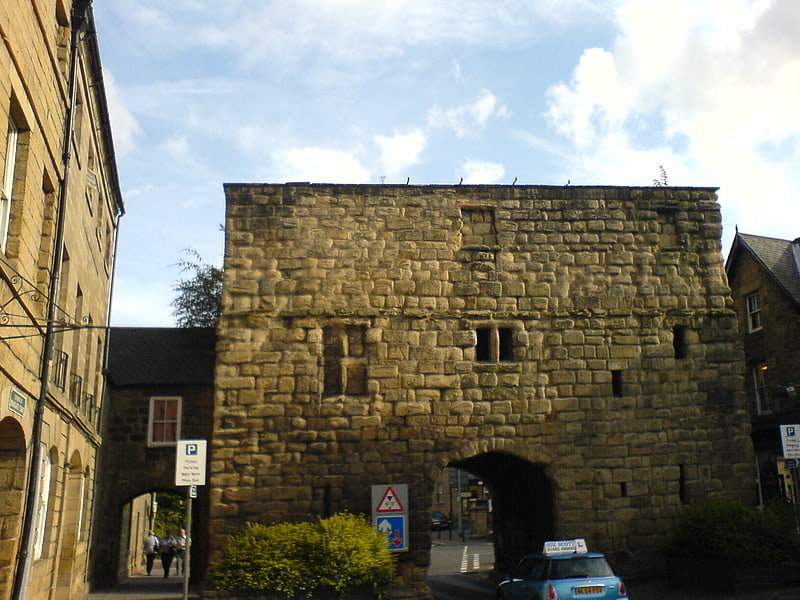
Bondgate Tower also known as the Hotspur Tower or the Hotspur Gateway in reference to Sir Henry Percy commonly known as Harry Hotspur son of the 1st Earl of Northumberland and father of the 2nd Earl of Northumberland. Although commonly called a tower it is actually a gatehouse of three stories constructed of stone and consists of a recessed archway flanked by two polygonal towers. It is located in Alnwick, Northumberland in the United Kingdom. The gatehouse crosses the road called Bondgate known by its road number as the B6346 the main road of Alnwick and low height traffic can pass though its entrance while tall height traffic take divestions to get past. A licence was granted in the 1430s by Henry V to Henry Percy 2nd Earl of Northumberland to wall the town and add battlements. These took fifty years to complete, with Bondgate Tower being finished around 1450.[7]
St Michael's Church
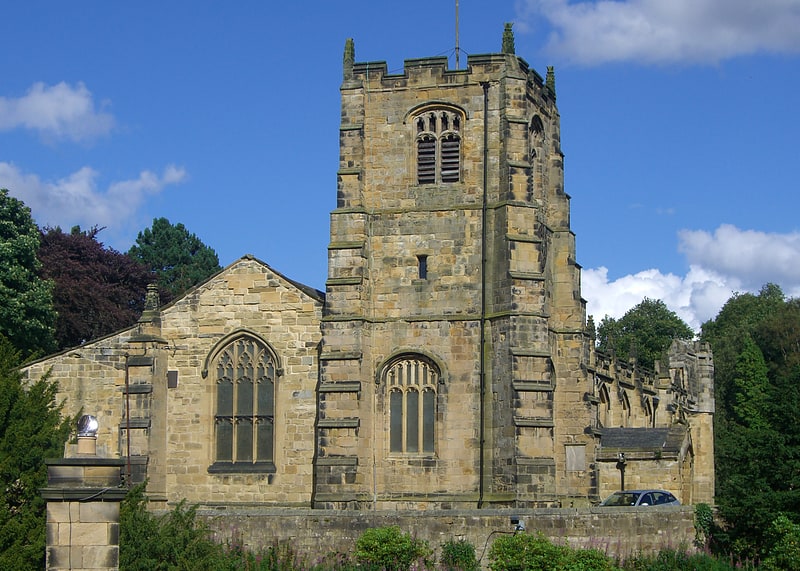
Building in Alnwick, England. St Michael's Church is an Anglican place of worship situated on Bailiffgate in the town of Alnwick in Northumberland, England. The current building dates from the 15th century but a 12th-century Norman chapel stood on the site prior to this; reports of an earlier 8th-century Saxon chapel are unconfirmed. The church is dedicated to St Michael the Archangel, in earlier times it was also dedicated to St Mary as well. It is a Grade I listed building which is included in the book “England's Thousand Best Churches".[8]
Address: 12 Bailiffgate, NE66 1NP Alnwick
Alnwick Playhouse
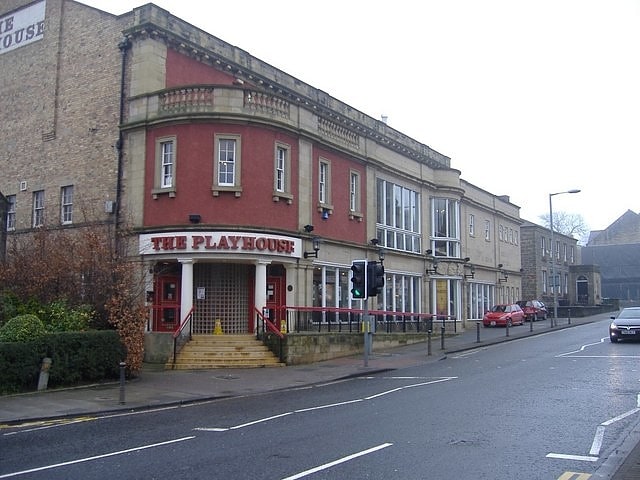
Theatre in Alnwick, England. The Alnwick Playhouse is an arts centre, theatre and cinema in the town of Alnwick in Northumberland, England. It is also the headquarters of the NTC Touring Theatre Company.
The building itself consists of many different parts. There is the main stage (with green room behind it) and an auditorium that sits over 200 people. Underneath the auditorium is a bar area with seating. On the ground floor, there is a foyer, a box office, a workshop, the NTC Touring Company office and a small 'black box theatre' style performance/rehearsal space with some limited seating.[9]
Address: Alnwick, Bondgate Without
Tenantry Column
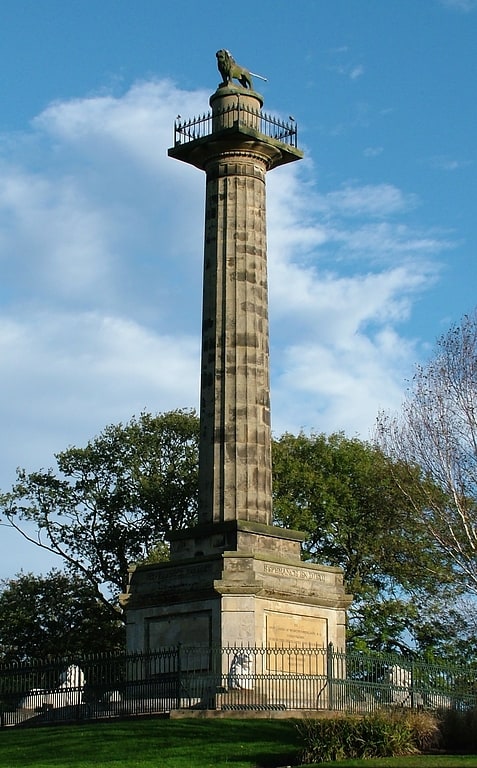
Park in Alnwick, England. The Tenantry Column is a monument to the south of Alnwick town centre, in Northumberland, England. It was erected in 1816 by the tenants of Hugh Percy, 2nd Duke of Northumberland in thanks for his reduction of their rents during the post-Napoleonic depression. It is a Doric column standing 83 feet tall and surmounted by a lion en passant, the symbol of the Percy family. Four more lions stand on a platform at the base of the column. A muster roll of the Percy Tenantry Volunteers was sealed into the foundation. The structure was granted protection as a listed building in 1952 and since 1977 has been listed in the highest category, grade I.[10]
Ellingham Hall
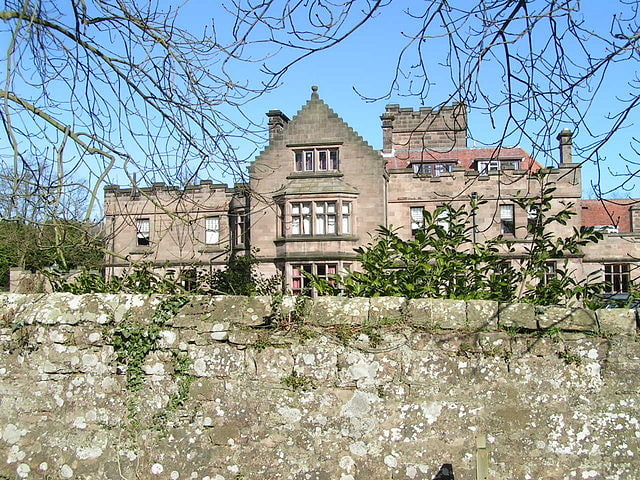
Ellingham Hall, Northumberland is an English country house in the county of Northumberland, in the civil parish of Ellingham.
The hall was built in the 17th century by Sir John Haggerston on the site of an earlier building. It was enlarged under the ownership of his successor, Edward Haggerston, but suffered severe damage in a fire that burned most of the East wing to the ground. The Haggerstons sheltered Catholic priests within secret tunnels and chambers during the persecutions of the Reformation.
In the Second World War, the Ellingham estate was farmed by the Women's Land Army who put the tennis courts into cultivation and used the reception rooms as a food storage centre. From 1955 to 1988 the hall was used a preparatory school for boys aged 5 to 18. It was subsequently bought by property developers but a plan to convert the building into residential flats and houses on the land was usurped by NatWest bank during the crash of 1989, despite being offered 25% interest until the properties were sold; thereafter the hall was left standing empty and vulnerable to vandalism and the elements. It was bought in 1995 by Helen and Aidan Ruff, who restored and renovated it to serve as a country house venue for holiday rental, parties, weddings and corporate events. The refurbished building was reopened in 2003. In May 2010, the chapel was gutted by fire.
In December 2010, Ellingham Hall found itself bombarded by calls after WikiLeaks founder Julian Assange was bailed to stay at its namesake, Ellingham Hall, Norfolk. Owner Aidan Ruff told The Journal newspaper: "We’re just trying to make an honest living, and deliver our brides and grooms the dream weddings they want. We’re not interested in bringing down governments or world domination."[11]